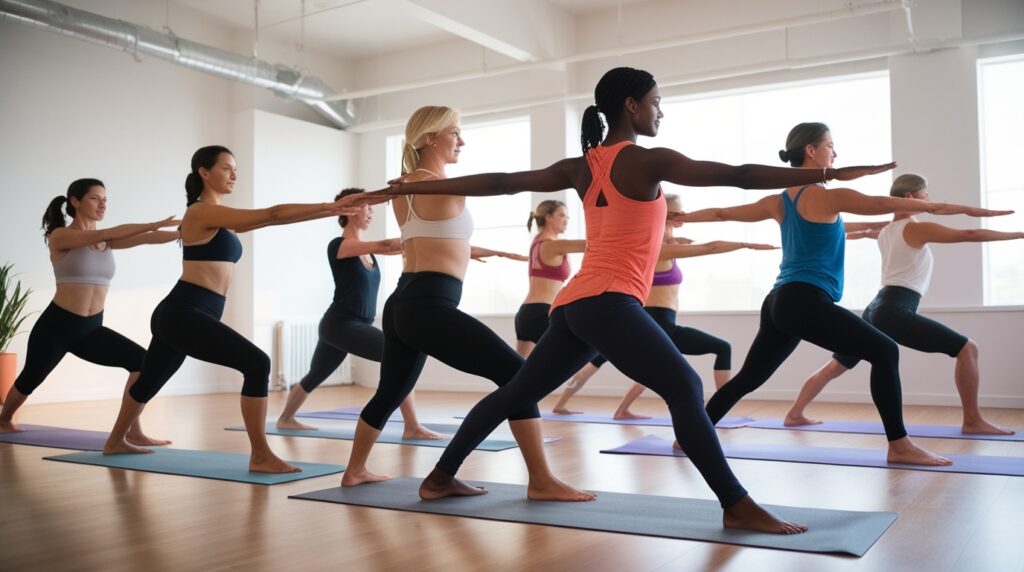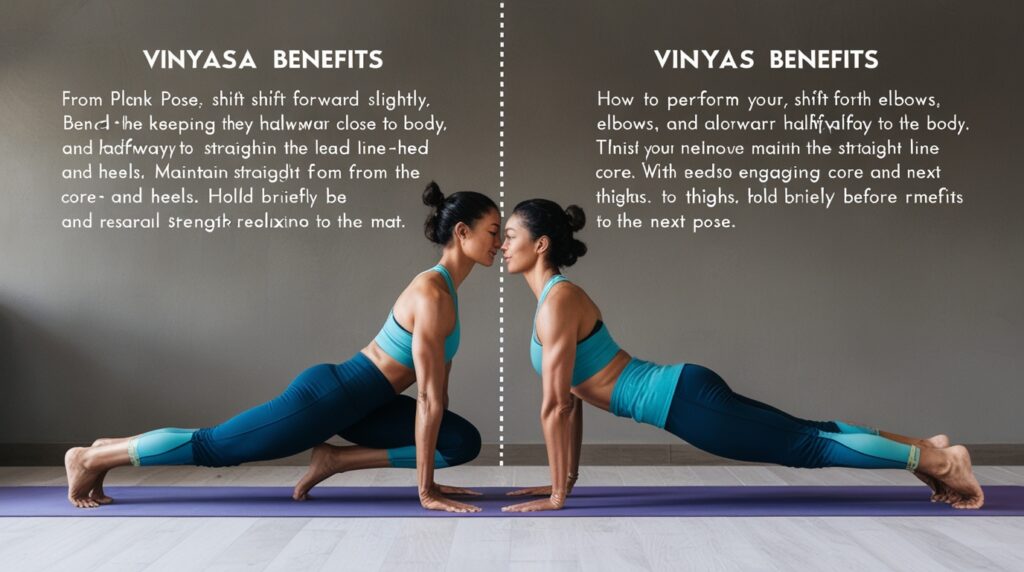Vinyasa Yoga Poses has surged in popularity, captivating yoga enthusiasts with its dynamic flow and emphasis on breath synchronization. Unlike other yoga styles that may focus on holding poses for extended periods, Vinyasa Yoga emphasizes movement and fluid transitions, making it an excellent choice for those seeking both strength and flexibility. This comprehensive guide delves into the essence of Vinyasa Yoga, explores its myriad benefits, and introduces essential poses to enhance your practice.

Vinyasa Yoga Poses
Table of Contents
Introduction to Vinyasa Yoga Poses
Vinyasa Yoga, often referred to as “flow yoga,” is characterized by its seamless movement from one pose to another, guided by the breath. The term “Vinyasa” is derived from the Sanskrit words “nyasa,” meaning “to place,” and “vi,” meaning “in a special way.” Together, they signify a methodical approach to transitioning between poses, creating a dance-like sequence that harmonizes body and mind.
The Essence of Vinyasa Yoga
At its core, Vinyasa Yoga is about connecting breath with movement. Each inhale and exhale corresponds to a specific movement, fostering a meditative state that enhances focus and mindfulness. This synchronization not only promotes physical well-being but also cultivates mental clarity and emotional balance.
Differences Between Vinyasa and Other Yoga Styles
While all yoga forms emphasize breath and movement, Vinyasa Yoga distinguishes itself through its fluidity and variety. Unlike Hatha Yoga, which typically involves holding poses longer, or Ashtanga Yoga, which follows a set sequence, Vinyasa allows for creativity and personalization in each session. This adaptability makes it suitable for practitioners of all levels, from beginners to advanced yogis.
Benefits of Vinyasa Yoga Poses
Engaging in Vinyasa Yoga offers a plethora of benefits that extend beyond the physical realm. By incorporating a series of dynamic poses, practitioners can experience enhanced strength, flexibility, and overall well-being.
Physical Benefits
- Enhanced Strength: Vinyasa Yoga involves various weight-bearing poses that build muscular strength, particularly in the core, arms, legs, and back.
- Improved Flexibility: The continuous movement helps elongate muscles and increase joint mobility, reducing the risk of injuries.
- Cardiovascular Health: The rhythmic flow elevates the heart rate, contributing to improved cardiovascular endurance and stamina.
- Weight Management: The combination of strength training and cardio elements aids in burning calories and maintaining a healthy weight.
Mental and Emotional Benefits
- Stress Reduction: The focus on breath and movement fosters relaxation, lowering cortisol levels and alleviating stress.
- Mental Clarity: The meditative aspect of Vinyasa Yoga enhances concentration and cognitive function.
- Emotional Balance: Regular practice promotes emotional resilience, helping individuals navigate life’s challenges with grace and composure.
Holistic Well-Being
Vinyasa Yoga not only strengthens the body but also nurtures the mind and spirit. By fostering a deep connection between breath and movement, it encourages a state of mindfulness that permeates all aspects of life, promoting holistic well-being.
Top 5 Vinyasa Yoga Poses for Strength
Building strength is a fundamental aspect of Vinyasa Yoga. The following poses are particularly effective in enhancing muscular endurance and power.

1. Plank Pose (Phalakasana)
Description: Plank Pose is a cornerstone of Vinyasa Yoga, engaging multiple muscle groups simultaneously. It strengthens the core, shoulders, arms, and legs, providing a solid foundation for more advanced poses.
How to Perform:
- Begin in a tabletop position with hands directly under shoulders.
- Step back one foot at a time, extending the legs behind you.
- Maintain a straight line from head to heels, engaging the core and keeping the hips aligned.
- Hold the pose, focusing on steady breathing.
Benefits:
- Enhances core stability
- Strengthens upper body
- Improves posture
2. Chaturanga Dandasana (Four-Limbed Staff Pose)
Description: Often referred to as the yoga push-up, Chaturanga Dandasana targets the arms, shoulders, and core. It is integral to many Vinyasa sequences, building the strength necessary for arm balances and inversions.

How to Perform:
- From Plank Pose, shift forward slightly.
- Bend the elbows, keeping them close to the body, and lower halfway to the mat.
- Maintain a straight line from head to heels, engaging the core and thighs.
- Hold briefly before transitioning to the next pose.
Benefits:
- Strengthens arms and shoulders
- Engages the core
- Prepares the body for more challenging poses
3. Warrior II (Virabhadrasana II)
Description: Warrior II is a powerful stance that builds strength in the legs and core while promoting balance and focus. It embodies the warrior spirit, encouraging determination and resilience.

How to Perform:
- Stand with legs wide apart, turning the right foot out 90 degrees and the left foot slightly inward.
- Bend the right knee, ensuring it aligns over the ankle.
- Extend the arms parallel to the floor, gazing over the right fingertips.
- Hold the pose, then switch sides.
Benefits:
- Strengthens legs and ankles
- Opens the hips and chest
- Enhances concentration and stamina
4. Boat Pose (Navasana)
Description: Boat Pose is an excellent core-strengthening exercise that also engages the hip flexors and spine. It challenges balance and stability, contributing to overall body strength.

How to Perform:
- Sit on the mat with knees bent and feet flat on the floor.
- Lean back slightly, lifting the feet off the ground.
- Extend the legs, keeping them parallel to the floor, and raise the arms alongside the legs.
- Maintain a straight spine, engaging the core.
- Hold the pose, focusing on breath control.
Benefits:
- Strengthens the abdominal muscles
- Enhances balance and coordination
- Tones the spine and hip flexors
5. Crow Pose (Bakasana)
Description: Crow Pose is an arm balance that requires both strength and focus. It builds upper body strength, particularly in the arms and wrists, while enhancing core stability and mental concentration.

How to Perform:
- Begin in a squat with knees wide and feet close to the hips.
- Place the hands on the mat, shoulder-width apart, and spread the fingers.
- Shift the weight forward, lifting the hips and bringing the knees onto the upper arms.
- Balance the body, engaging the core, and gaze forward.
- Hold the pose, gradually increasing the duration as strength improves.
Benefits:
- Strengthens the arms, shoulders, and wrists
- Enhances core stability
- Improves balance and focus
Top 5 Vinyasa Yoga Poses for Flexibility
Flexibility is another significant benefit of Vinyasa Yoga, achieved through dynamic stretching and controlled movements. The following poses are instrumental in increasing suppleness and range of motion.
1. Downward-Facing Dog (Adho Mukha Svanasana)
Description: Downward-Facing Dog is a staple in Vinyasa sequences, stretching the hamstrings, calves, and spine. It also strengthens the arms and shoulders, making it a versatile pose for flexibility and strength.
How to Perform:
- Start on hands and knees, with wrists under shoulders and knees under hips.
- Lift the hips toward the ceiling, straightening the legs as much as possible.
- Press the heels toward the floor and relax the head between the arms.
- Hold the pose, breathing deeply.
Benefits:
- Stretches the entire back body
- Relieves tension in the spine
- Strengthens the upper body
2. Triangle Pose (Trikonasana)
Description: Triangle Pose enhances flexibility in the legs, hips, and spine while promoting lateral stretching. It also improves balance and opens the chest and shoulders.
How to Perform:
- Stand with feet wide apart, turning the right foot out 90 degrees and the left foot slightly inward.
- Extend the arms parallel to the floor, reaching forward with the right hand.
- Hinge at the hip, lowering the right hand to the shin or a block while extending the left arm upward.
- Gaze toward the left hand, maintaining a long spine.
- Hold the pose, then switch sides.
Benefits:
- Stretches the hamstrings, hips, and spine
- Opens the chest and shoulders
- Enhances balance and stability
3. Pigeon Pose (Eka Pada Rajakapotasana)
Description: Pigeon Pose is a deep hip opener that targets the glutes, hip flexors, and lower back. It is particularly effective in releasing tension and increasing hip flexibility.
How to Perform:
- Begin in Downward-Facing Dog.
- Bring the right knee forward and place it behind the right wrist, extending the left leg back.
- Lower the hips toward the mat, ensuring the right shin is parallel to the front edge.
- Extend the arms forward or fold over the right leg.
- Hold the pose, then switch sides.
Benefits:
- Deeply stretches the hips and glutes
- Relieves lower back tension
- Enhances hip mobility
4. Seated Forward Bend (Paschimottanasana)
Description: Seated Forward Bend is a calming pose that stretches the spine, hamstrings, and lower back. It promotes relaxation and introspection, making it a perfect counterpose after dynamic movements.
How to Perform:
- Sit with legs extended straight in front of you.
- Inhale, lengthen the spine, and reach the arms overhead.
- Exhale, hinge at the hips, and fold forward, reaching for the feet or shins.
- Maintain a straight back, avoiding rounding the spine excessively.
- Hold the pose, breathing deeply.
Benefits:
- Stretches the hamstrings and spine
- Calms the nervous system
- Enhances flexibility in the back and legs
5. Camel Pose (Ustrasana)
Description: Camel Pose is a backbend that opens the chest, shoulders, and hip flexors while stretching the entire front body. It also strengthens the back and improves spinal flexibility.
How to Perform:
- Kneel on the mat with knees hip-width apart and thighs perpendicular to the floor.
- Place the hands on the lower back, fingers pointing downward.
- Inhale, lift the chest, and gently arch the back.
- Optionally, reach the hands to the heels, maintaining the arch.
- Hold the pose, breathing deeply, then release.
Benefits:
- Opens the chest and shoulders
- Stretches the hip flexors and spine
- Strengthens the back muscles
Conclusion
Remember, the essence of Vinyasa Yoga lies in the seamless integration of breath and movement. Embrace each session with mindfulness, patience, and dedication, and witness the profound impact it has on your overall well-being. Whether you’re a seasoned yogi or a beginner, Vinyasa Yoga provides a pathway to strength, flexibility, and inner peace, guiding you towards a healthier and more balanced life.
